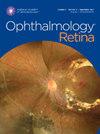Detection of Center-Involved Diabetic Macular Edema With Visual Impairment Using Multimodal Artificial Intelligence Algorithms
IF 5.7
Q1 OPHTHALMOLOGY
引用次数: 0
Abstract
Purpose
To develop artificial intelligence (AI) models for automated detection of center-involved diabetic macular edema (CI-DME) with visual impairment using color fundus photographs (CFPs) and OCT scans.
Design
Artificial intelligence effort using pooled data from multicenter studies.
Participants
Data sets consisted of diabetic participants with or without CI-DME, who had CFP, OCT, and best-corrected visual acuity (BCVA) obtained after manifest refraction. The development data set was from DRCR Retina Network clinical trials, external testing data set 1 was from the Singapore National Eye Centre, Singapore, and external testing data set 2 was from the Eye Clinic, IRCCS MultiMedica, Milan, Italy.
Methods
Artificial intelligence models were trained to detect CI-DME, visual impairment (BCVA 20/32 or worse), and CI-DME with visual impairment, using CFPs alone, OCTs alone, and both CFPs and OCTs together (multimodal). Data from 1007 eyes were used to train and validate the algorithms, and data from 448 eyes were used for testing.
Main Outcome Measures
Area under the receiver operating characteristic curve (AUC) values.
Results
In the primary testing set, the CFP model, OCT model, and multimodal model had AUCs of 0.848 (95% confidence interval [CI], 0.787–0.900), 0.913 (95% CI, 0.870–0.947), and 0.939 (95% CI, 0.906–0.964), respectively, for detection of CI-DME with visual impairment. In external testing data set 1, the CFP, OCT, and multimodal models had AUCs of 0.756 (95% CI, 0.624–0.870), 0.949 (95% CI, 0.889–0.989), and 0.917 (95% CI, 0.837–0.979), respectively, for detection of CI-DME with visual impairment. In external testing data set 2, the CFP, OCT, and multimodal models had AUCs of 0.881 (95% CI, 0.822–0.940), 0.828 (95% CI, 0.749–0.905), and 0.907 (95% CI, 0.852–0.952), respectively, for detection of CI-DME with visual impairment.
Conclusions
The AI models showed good diagnostic performance for the detection of CI-DME with visual impairment. The multimodal (CFP and OCT) model did not offer additional benefit over the OCT model alone. If validated in prospective studies, these AI models could potentially help to improve the triage and detection of patients who require prompt treatment.
Financial Disclosure(s)
Proprietary or commercial disclosure may be found in the Footnotes and Disclosures at the end of this article.
使用多模态人工智能算法检测中心受累的糖尿病黄斑水肿伴视力损害。
目的:建立人工智能(AI)模型,利用彩色眼底照片(CFP)和光学相干断层扫描(OCT)自动检测伴有视力障碍的中心受累型糖尿病黄斑水肿(CI-DME)。设计:人工智能使用来自多中心研究的汇总数据。参与者:数据集包括伴有或不伴有CI-DME的糖尿病参与者,他们具有CFP、OCT和明显屈光后获得的最佳矫正视力(BCVA)。开发数据集来自DRCR视网膜网络临床试验,外部测试数据集1来自新加坡新加坡国家眼科中心,外部测试数据集2来自意大利米兰IRCCS MultiMedica眼科诊所。方法:训练人工智能模型检测CI-DME、视力障碍(BCVA 20/32及以下)、CI-DME伴视力障碍、单独使用CFPs、单独使用OCTs、CFPs和OCTs联合使用(多模式)。来自1007只眼睛的数据用于训练和验证算法,来自448只眼睛的数据用于测试。主要观察指标:受试者工作特征曲线下面积(AUC)值。结果:在初级检验集中,CFP模型、OCT模型和多模态模型检测CI- dme合并视力障碍的auc分别为0.848 (95% CI 0.787 ~ 0.900)、0.913 (95% CI 0.870 ~ 0.947)和0.939 (95% CI 0.906 ~ 0.964)。在外部测试数据集1中,CFP、OCT和多模态模型检测CI- dme伴有视力障碍的auc分别为0.756 (95% CI 0.624-0.870)、0.949 (95% CI 0.889-0.989)和0.917 (95% CI 0.837-0.979)。在外部测试数据集2中,CFP、OCT和多模态模型检测CI- dme伴有视力障碍的auc分别为0.881 (95% CI 0.822-0.940)、0.828 (95% CI 0.749-0.905)和0.907 (95% CI 0.852-0.952)。结论:人工智能模型对CI-DME合并视力障碍有较好的诊断效果。与单独的OCT模型相比,多模式(CFP和OCT)模型没有提供额外的好处。如果在前瞻性研究中得到验证,这些人工智能模型可能有助于改善需要及时治疗的患者的分诊和检测。
本文章由计算机程序翻译,如有差异,请以英文原文为准。
求助全文
约1分钟内获得全文
求助全文

 求助内容:
求助内容: 应助结果提醒方式:
应助结果提醒方式:


